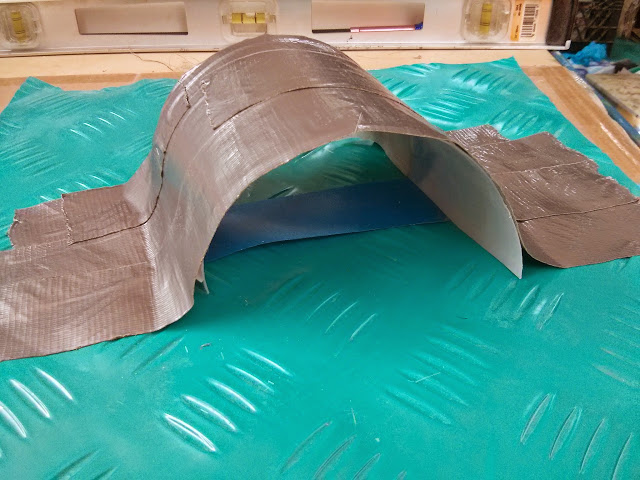When constructing the 25" long conduit running under the ice box ( see – January
17th Post) I used prefabricated, 1” thick foam core paneling. The paneling provided additional
insulation under the box and the completed assembly added structurally to the hull by serving as a stringer between two transverse bulkheads.
The 5” long section of conduit running between the aft panel of
the ice box and the new cockpit locker bulkhead does not need to provide additional
insulation nor contribute structurally.
It’s sole function is to provide a water tight passage way under the ice
box insulation. Thus I chose a quicker
and less costly method for building a conduit…
 |
| Save for some two-part epoxy all the components of the conduit fabrication are pictured |
Using a plastic, 1G jug and some duct tape I created a
fiberglass mold for the section of conduit required.
 |
| The duct tape serves as a mold release agent and as part of the mold. |
I began by cutting the jug in half.
To assist in maintaining the shape of the plastic ran one strip of tape
across the open face of the jug. I then
placed the jug on a board covered with plastic sheeting and covered it with
duct tape. Epoxy will not bond to duct
tape so it serves in place of mold release wax.
The duct tape also allowed me to create a nice radius at the
intersection of the jug and the base.
 |
| Test fitting the 1708 cloth on the mold. |
I then cut a section of 1708 cloth to cover the mold. One layer of cloth was adequate for my
application, but additional layers could be added to create a load bearing
conduit.
 |
| Time to walk away and let the epoxy cure. |
I then wet out the cloth and laid it over the mold and went
home for the night.
 |
| Conduit fresh off the mold. |
The next morning I lifted the conduit off the mold. While wearing leather gloves I dressed the
sharp, jagged edges by hand sanding with 35 grit paper then sanded the entire
piece with 80 grit sandpaper.
 |
| fitting the conduit to the hull and bulkhead. |
I fit the piece in position and marked the excess
material. The single layer of cloth cut
easily with a jig saw with a metal cutting blade. I believe that tin snips would also work for
shaping the piece. Fine tuning the fit
was done using 80 grit paper on an orbital sander.
 |
| Conduit bonded to hull and bulkhead with thickened epoxy and cloth tabbing. |
Once satisfied with the fit, I used two small sections of fiberglass
cloth to tab the base flanges to the hull.
I sealed the fore and aft ends of the conduit to the adjacent bulkheads
with a fillet of thickened epoxy.
Now it is time to bury the conduit under layers of ice box insulation.
More images and notes from this on-going project are
available in the Ice
Box Rebuild Photo Album.

No comments:
Post a Comment